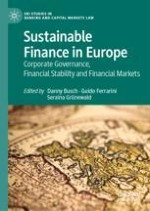2021 | OriginalPaper | Buchkapitel
9. Which Role for the Prudential Supervision of Banks in Sustainable Finance?
verfasst von : Antonio Luca Riso
Erschienen in: Sustainable Finance in Europe
Aktivieren Sie unsere intelligente Suche, um passende Fachinhalte oder Patente zu finden.
Wählen Sie Textabschnitte aus um mit Künstlicher Intelligenz passenden Patente zu finden. powered by
Markieren Sie Textabschnitte, um KI-gestützt weitere passende Inhalte zu finden. powered by
